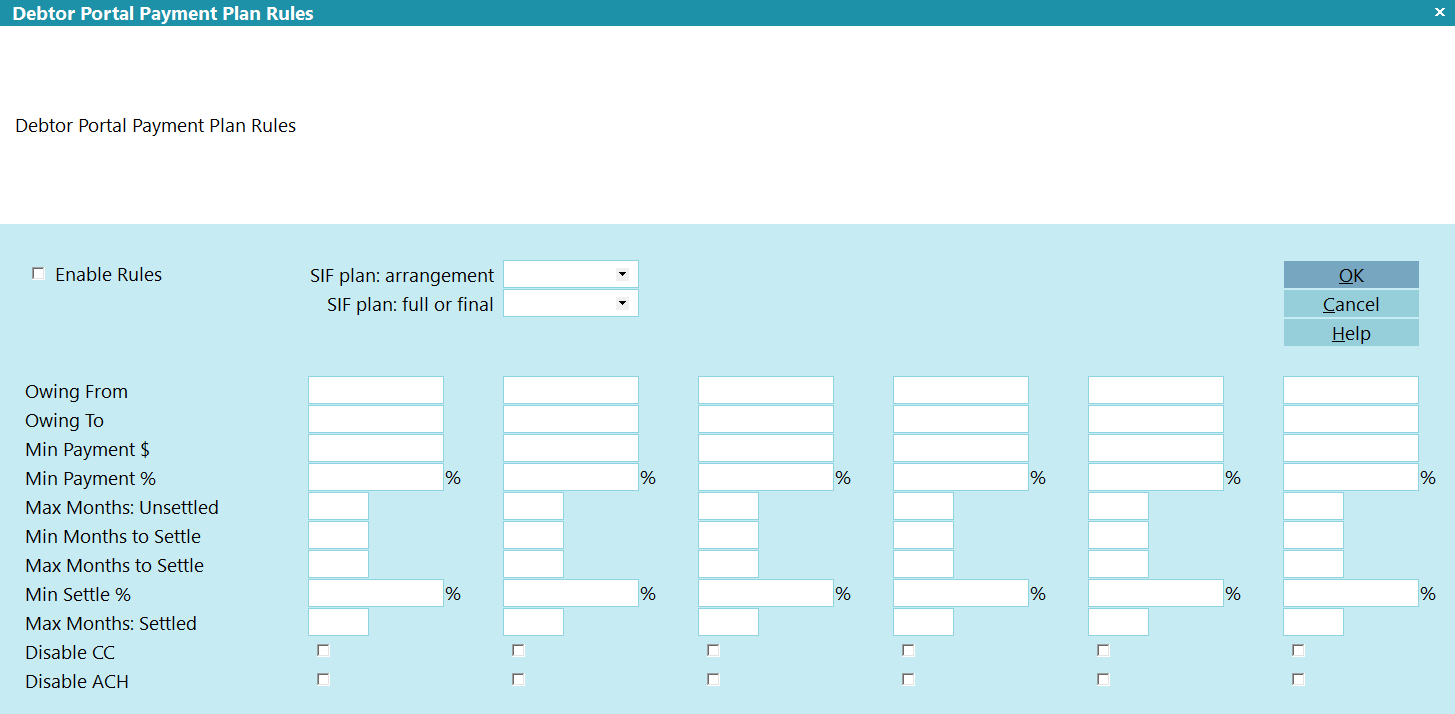Debtor Portal Payment Plan Rules
The Debtor Portal Payment Plan Rules screen is where you
can define rules for the Debtor Consumer portal for payment
plans and settlements.
This form is accessed via the menu path "System\Preferences\Payment
Processing Setup\Debtor Portal Rules".

Debtor Portal Payment Plan Rules
Rules are defined here globally. You can then enable
overrides on a client-by-client basis.
 You can even leave all the rules blank here, and only
set them on a client-by-client basis.
You can even leave all the rules blank here, and only
set them on a client-by-client basis.
Enable Rules
Check this box ON to enable the rules feature. Even if
nothing else is defined here, this box must still be set.
SIF PLAN: ARRANGEMENT
Enter a Contact Plan to run when a payment arrangement
is created.
SIF PLAN: FULL OR FINAL
Enter a Contact Plan to run when a Settle in Full occurs
in a single payment, or when the final payment of a payment
arrangement is processed.
 WARNING: In order to prevent a race condition where the
Contact Plan will run before the final payment,
the SIF Plan will be scheduled for the day
following the final payment.
WARNING: In order to prevent a race condition where the
Contact Plan will run before the final payment,
the SIF Plan will be scheduled for the day
following the final payment.
The following section has 6 possible ranges of rules. Not
all ranges need to be used, but the Owing From and Owing To
values should cover 0.00 to 999,999,999.00.

Owing From
Enter the lower boundary for this range.

Owing To
Enter the upper boundary for this range.
 WARNING: If you overlap boundaries, such as 0.00 to 1,000.00
and 1,000.00 to 2,500.00, then the lower rules will
be used. To prevent this, use the boundary, less
a penny. For example: 0.00 to 999.99 and 1,000.00
to 2,499.99, or 0.00 to 1,000.00 and 1,000.01 to
2,500.00.
WARNING: If you overlap boundaries, such as 0.00 to 1,000.00
and 1,000.00 to 2,500.00, then the lower rules will
be used. To prevent this, use the boundary, less
a penny. For example: 0.00 to 999.99 and 1,000.00
to 2,499.99, or 0.00 to 1,000.00 and 1,000.01 to
2,500.00.

Minimum Payment Dollar
When setting up a payment plan, this is the minimum dollar value
of a payment in a month. Enter the minimum payment amount for
a month.
This value is compared to the calculated value from Minimum
Payment Percentage and the higher of the 2 values is used.
 This is a monthly value, so a value of $100, with
a weekly payment plan would mean a minimum payment
of $50 per week.
This is a monthly value, so a value of $100, with
a weekly payment plan would mean a minimum payment
of $50 per week.

Minimum Payment Percentage
When setting up a payment plan, this is the minimum percentage value
of a payment in a month. Enter the minimum payment percentage for
a month.
This value is compared to the value from Minimum Payment Dollar
and the higher of the 2 values is used.
MAXIMUM MONTHS: UNSETTLED
This field applies to payment plans that are not part of a
settlement.
Enter the maximum number of months that a payment plan can
go on for.
 This is number of months, not number of payments, so
a value of 12 on a weekly payment plan would be a
maximum of 52 payments.
This is number of months, not number of payments, so
a value of 12 on a weekly payment plan would be a
maximum of 52 payments.

Minimum Months Before Offering Settlement
Enter the number of months after the Debtor's Listed Date
before a settlement can be offered.
If the value is 0, then settlements will be available
immediately after placement.

Maximum Months To Offer Settlement
Enter the number of months after the Debtor's Listed Date
where settlement options will be available to the Debtor.
If the value is 0, then settlements will be available
indefinitely.

Minimum Settlement Percentage
Enter the lowest percentage amount that an account can be
settled for. For example, if the value is 80%, then the
account cannot be settled for less than 80%.
If the value is 0.00, then settlements will be disabled.
MAXIMUM MONTHS: SETTLED
This field applies to payment plans that are part of a
settlement.
Enter the maximum number of months that a payment plan can
go on for.

Disable CC
Check this box ON to disable credit/debit card payments.
 You can use this to disable card payments on balances
over a certain amount to avoid high convenience fees.
You can use this to disable card payments on balances
over a certain amount to avoid high convenience fees.

Disable ACH
Check this box ON to disable ACH/check payments.

| 
Was this page helpful? Do you have any comments on this document? Can we make it better? If so how may we improve this page.
Please click this link to send us your comments: helpinfo@collect.org